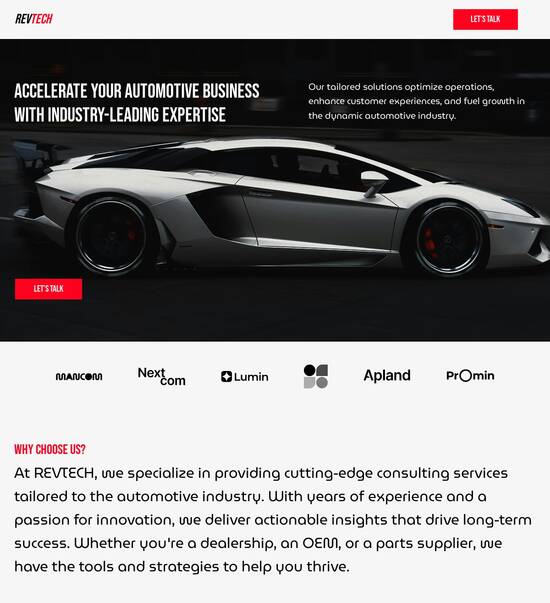
HTML page template for Commercial Real Estate
Use TemplateAbout template
Conquer your niche with our high-converting landing page templates for your Commercial Real Estate business. Let's boost conversion rates together!
Recommended templates

Easy to build without coding
With the intuitive drag-and-drop builder, anyone on your team can create high-converting pages without any knowledge of code or design. Make enhancements to your landing page with custom widgets using Javascript, HTML/CSS, or third-party scripts.

Multiple layouts for any industry and goal
Select from 500+ landing page layouts built to boost conversions across industry-specific scenarios. Customize them by adjusting fonts, adding images, and generating on-brand content with the AI assistant. Quickly scale with Instablocks® and Global Blocks that you can save, reuse, and update globally.

Loads fast and looks polished on any device
Every template is responsive, which means they present professionally on any device and load blazingly fast with our Thor Render Engine. You can also power them up with Google AMP technology to deliver an unparalleled mobile experience and drive higher conversions.

Robust analytics & experimentation
Get real-time updates and reporting across all your devices, showing the number of visitors, conversions, cost-per-visitor, and cost-per-lead. Launch AI-powered experiments, run A/B tests, and use heatmaps to analyze user behavior, then optimize your landing page to maximize conversions.







Easy to build without coding
With the intuitive drag-and-drop builder, anyone on your team can create high-converting pages without any knowledge of code or design. Make enhancements to your landing page with custom widgets using Javascript, HTML/CSS, or third-party scripts.
Multiple layouts for any industry and goal
Select from 500+ landing page layouts built to boost conversions across industry-specific scenarios. Customize them by adjusting fonts, adding images, and generating on-brand content with the AI assistant. Quickly scale with Instablocks® and Global Blocks that you can save, reuse, and update globally.
Loads fast and looks polished on any device
Every template is responsive, which means they present professionally on any device and load blazingly fast with our Thor Render Engine.
Robust analytics & experimentation
Get real-time updates and reporting across all your devices, showing the number of visitors, conversions, cost-per-visitor, and cost-per-lead. Launch AI-powered experiments, run A/B tests, and use heatmaps to analyze user behavior, then optimize your landing page to maximize conversions.
All the features you need to build real estate landing page html template
Explore more featuresLearn how to build real estate html template
FAQs
Leading the way in building high-performing landing pages





An all-in-one landing page platform for maximizing ROI
Creating effective landing pages is crucial for the success of any digital marketing strategy, especially for businesses in the USA. Instapage stands out as the most powerful landing page and conversion rate optimization (CRO) platform available. This guide will walk you through the steps to effectively leverage Instapage to enhance your campaigns and achieve high conversions.
Understanding the basics of landing pages
Landing pages are standalone web pages created specifically for a marketing or advertising campaign. They are designed to convert visitors into leads or customers by encouraging specific actions, such as filling out a form or clicking a button. Instapage simplifies the process of creating these focused pages by offering intuitive tools and templates that cater to various needs.
- High-converting templates: Choose from over 100 ready-made templates tailored for various industries.
- Easy-to-use page builder: The drag-and-drop builder allows marketers to create pages without needing coding skills.
- Integration capabilities: Connect with major marketing tools to streamline your campaigns.
Steps to create a successful landing page
Follow these steps to create an impactful landing page using Instapage:
- Choose a template that aligns with your campaign goals and target audience.
- Customize the template to fit your brand identity and messaging, ensuring that you highlight your value propositions clearly.
- Publish and promote your landing page, using SEO best practices and integrating social media channels to drive traffic.
Optimizing for conversions
Once your landing page is live, it’s vital to continuously optimize it for better performance. Here are practical tips:
- Utilize A/B testing features to experiment with different headlines and calls-to-action.
- Examine heatmaps to analyze visitor behavior and determine which elements attract the most attention.
- Track performance through analytics dashboards to assess conversion rates and tweak as needed.
By continually iterating and optimizing your landing pages, you can significantly improve your marketing ROI.
In conclusion, Instapage empowers marketers with the necessary tools to create effective landing pages that drive results.
Ready to transform your digital marketing efforts? Start using Instapage today to maximize your campaign outcomes.
HTML page template for commercial real estate
Understanding the essence of HTML page templates in commercial real estate
HTML page templates serve as foundational building blocks in web development, particularly in the commercial real estate sector. These templates define the structure, style, and functionality of a web page, allowing developers and marketers to showcase properties effectively. An HTML template outlines how content is organized, including elements like headers, footers, and navigation menus, all of which contribute to a cohesive user experience.
The importance of templates in web development cannot be overstated. They ensure consistency across multiple pages, enabling businesses to maintain a professional appearance while saving time on design. In the commercial real estate field, where first impressions can significantly impact client engagement, having a well-crafted HTML template is crucial for attracting potential buyers or renters.
With user experience at the forefront, HTML templates are designed to enhance interactions. For real estate businesses, this translates to easily navigable websites that offer streamlined marketing efforts. Furthermore, using templates helps solidify brand consistency, ensuring that marketing materials are cohesive and recognizable across platforms. This awareness can lead to increased brand trust, which is paramount in the competitive world of commercial real estate.
Core functions and features of HTML page templates
When evaluating HTML page templates, several core functions and features are essential for efficiently showcasing commercial real estate listings. One of the primary advantages is simplified customization. Many templates come with pre-designed layouts that are easy to manipulate, allowing businesses to create a tailored user experience without extensive coding knowledge.
These layouts often include modular components, making them suitable for businesses of all sizes. Whether a small agency or a large corporation, the flexibility in design helps accommodate various marketing needs. This adaptability proves beneficial as real estate professionals can focus more on their strategies rather than getting bogged down in technical details.
Responsive design capabilities adapt the website layout for various devices.
Advanced SEO optimization features such as integrated meta tags for better search visibility.
Multimedia support for images, videos, and virtual tours enhances property showcases.
Responsive design capabilities allow these templates to adapt seamlessly to various devices and screen sizes, which is increasingly important in today’s mobile-centric world. With many potential clients browsing on smartphones or tablets, having a mobile-optimized site can significantly boost visibility and engagement rates. SEO optimization features within these templates further enhance their effectiveness, helping real estate listings appear higher in search results and drawing more traffic to the site.
Leveraging advanced HTML functionality for engagement
Effective engagement strategies are essential for commercial real estate websites. One advanced HTML functionality that enhances user interaction is the use of event listeners, specifically through the `document.addEventListener` method. By incorporating event listeners, you can create responsive design elements such as dropdown menus for property filters or image carousels for showcasing listings. These dynamic elements not only make the site visually appealing but also provide users with a more interactive experience.
In addition, creating interactive maps can significantly enhance user engagement. By embedding services like Google Maps into the HTML templates, real estate companies can provide potential buyers with location-based insights directly on their listings. This feature allows users not only to see where properties are located but also to understand the surrounding amenities, further informing their decision-making process.
Utilizing optimized images and scripts to ensure fast load times.
Implementing caching strategies to enhance performance.
Employing asynchronous loading for heavy elements to improve user experience.
Fast load times are another critical aspect of user engagement. A site that takes too long to load can lead to high bounce rates, as users often abandon a page that doesn’t meet their expectations. Techniques for optimizing loading speed include minimizing image sizes, leveraging browser caching, and employing asynchronous loading for scripts. Together, these enhancements create a seamless experience for users exploring your commercial real estate offerings.
The significance of `DOMContentLoaded` in template functionality
Understanding the `DOMContentLoaded` event is crucial for optimizing HTML page template functionality. This event fires when the initial HTML document has been completely loaded and parsed, meaning that the DOM is ready for interaction. By ensuring scripts run only after this event, developers can enhance the speed of interactive elements loading on their website. This practice is particularly valuable for commercial real estate templates where timely loading of property details can greatly impact user satisfaction.
In commercial real estate templates, effective use of `DOMContentLoaded` ensures that vital elements, such as property filters or image galleries, are ready for user interaction right from the start. By prioritizing seamless user experience during initial page load, businesses can prevent potential clients from feeling frustrated while waiting for content to appear. This attention to detail can lead to better user retention and ultimately higher conversion rates.
Strategically placing scripts at the bottom of the body tag to optimize loading speed.
Avoiding inline scripts that can block rendering of the page.
Implementing best practices for event handling to prevent memory leaks.
Best practices for integrating `DOMContentLoaded` include placing scripts at the end of the body to ensure the HTML document loads first. Additionally, avoiding inline scripts that can block the rendering of the page helps maintain a smooth user experience. Following these guidelines not only accelerates page load times but also contributes to efficient memory usage, resulting in a more robust application for commercial real estate websites.
Innovative template elements tailored for commercial real estate
As the commercial real estate market evolves, innovative template elements become increasingly critical. One of these elements is custom lead capture forms, which are essential for maximizing engagement with potential clients. Designing effective inquiry forms that are easy to navigate can significantly contribute to capturing client data in real-time. By streamlining the lead collection process, real estate businesses can enhance their follow-up strategies and improve conversion rates.
Another innovative feature is the property comparison tool. A user-friendly interface that enables potential clients to compare listings side by side can enhance the decision-making process. By implementing filters, users can tailor their searches based on specific criteria such as price, location, and property type, contributing to a personalized experience that caters to individual preferences.
Incorporating testimonials sections to build credibility.
Designing case studies showcases to detail successful transactions.
Creating an appealing layout that highlights social proof effectively.
Adding sections for testimonials and case studies can further enhance a website's credibility. Customers value social proof, and effectively displaying client reviews can help build trust. By ensuring that these elements are visually engaging and accessible, real estate businesses can create a compelling narrative that encourages potential clients to reach out.
Case studies: Successful implementations of HTML templates in commercial real estate
Analyzing notable commercial real estate websites reveals the artistry and functionality achieved through effective HTML page templates. A careful review of aesthetic and functional elements can yield valuable insights into what works well in the industry. Many top-tier websites include high-quality images, intuitive navigation, and engaging user experiences that enhance client interaction. These factors not only create an attractive presentation but also drive potential buyers to explore listings thoroughly.
Discussions of user engagement metrics offer another layer of understanding. For instance, tracking bounce rates, time on page, and conversion statistics can spotlight opportunities for optimization. Learning from successful brands in the commercial real estate space can help others refine their approach and adopt best practices that resonate with their target demographic.
Quality imagery is crucial for showcasing properties effectively.
User-friendly navigation assists in holding visitor interest.
Engaging elements drive user interaction and increase conversions.
Key takeaways from these case studies include the importance of quality imagery, user-friendly navigation, and engaging elements that drive interaction. Collectively, these insights can guide businesses in tailoring their HTML templates to align with the expectations of modern clients in commercial real estate.
Future directions: The evolution of HTML templates in real estate marketing
As we look to the future, the incorporation of AI and machine learning into HTML templates represents a significant evolution in real estate marketing. By leveraging data analytics, businesses can create personalized experiences through automated recommendations, helping clients find properties that meet their specific needs. Additionally, AI can assist in predictive analysis, providing insights into property value assessments and market trends.
Enhancing virtual reality integration is another crucial direction. Immersive property viewing experiences can bridge gaps between online and offline viewings. Integrating virtual reality options into HTML templates can allow clients to explore properties from the comfort of their homes, giving them a comprehensive understanding of each listing.
Adapting templates to shifting consumer preferences.
Maintaining flexibility to incorporate emerging technologies.
Understanding the importance of user behavior insights.
Anticipating changes in user behavior further prepares the ground for successful marketing strategies. As consumer preferences shift, real estate businesses must remain vigilant and adaptable, integrating the latest technologies into their HTML templates. Staying attuned to user behavior insights allows companies to craft experiences that resonate with potential clients, ensuring they stay competitive in a dynamic market.
Crafting the perfect HTML page template: Best practices
Building effective HTML page templates requires attention to essential components. User-centric design principles are vital; the layout should reflect ease of navigation and a pleasant visual experience. Equally important is maintaining functional aesthetics. Aesthetically pleasing templates should not compromise functionality; instead, they should enhance usability while displaying properties effectively.
Continual testing and optimization strategies are necessary to ensure quality and effectiveness. Whether through A/B testing different landing page elements or gathering organic feedback, implementing improvements can lead to increased conversions. Real estate websites should prioritize consistent updates to stay relevant and align with changing user expectations.
Engage in regular A/B testing to optimize landing pages.
Establish feedback loops for continuous improvement.
Invest in ongoing education about industry trends.
Staying current on industry trends is essential for effective template design. By following innovative ideas and practices, real estate businesses can enhance their approaches, ensuring they meet market demands while maximizing conversion rates. Regularly revisiting and refining page templates keeps businesses aligned with customer preferences and technological advancements.
Ready to skyrocket conversions?
Supercharge your ad campaigns with high-performing landing pages
Get started














